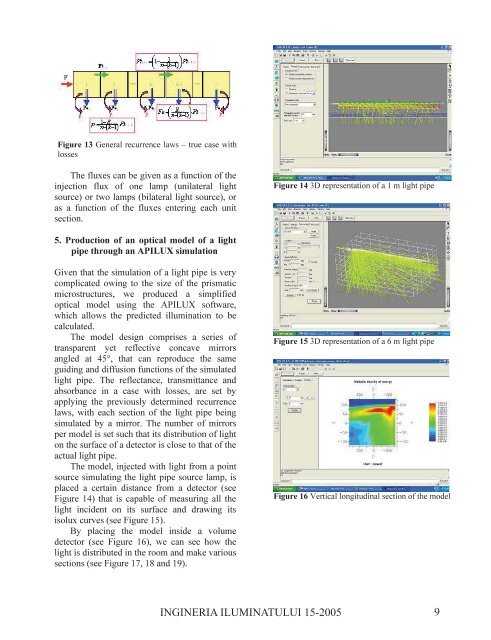Ingineria Iluminatului - Journal of Lighting Engineering - Prof. Florin ...
Ingineria Iluminatului - Journal of Lighting Engineering - Prof. Florin ...
Ingineria Iluminatului - Journal of Lighting Engineering - Prof. Florin ...
You also want an ePaper? Increase the reach of your titles
YUMPU automatically turns print PDFs into web optimized ePapers that Google loves.
Figure 13 General recurrence laws – true case with<br />
losses<br />
The fluxes can be given as a function <strong>of</strong> the<br />
injection flux <strong>of</strong> one lamp (unilateral light<br />
source) or two lamps (bilateral light source), or<br />
as a function <strong>of</strong> the fluxes entering each unit<br />
section.<br />
5. Production <strong>of</strong> an optical model <strong>of</strong> a light<br />
pipe through an APILUX simulation<br />
Given that the simulation <strong>of</strong> a light pipe is very<br />
complicated owing to the size <strong>of</strong> the prismatic<br />
microstructures, we produced a simplified<br />
optical model using the APILUX s<strong>of</strong>tware,<br />
which allows the predicted illumination to be<br />
calculated.<br />
The model design comprises a series <strong>of</strong><br />
transparent yet reflective concave mirrors<br />
angled at 45°, that can reproduce the same<br />
guiding and diffusion functions <strong>of</strong> the simulated<br />
light pipe. The reflectance, transmittance and<br />
absorbance in a case with losses, are set by<br />
applying the previously determined recurrence<br />
laws, with each section <strong>of</strong> the light pipe being<br />
simulated by a mirror. The number <strong>of</strong> mirrors<br />
per model is set such that its distribution <strong>of</strong> light<br />
on the surface <strong>of</strong> a detector is close to that <strong>of</strong> the<br />
actual light pipe.<br />
The model, injected with light from a point<br />
source simulating the light pipe source lamp, is<br />
placed a certain distance from a detector (see<br />
Figure 14) that is capable <strong>of</strong> measuring all the<br />
light incident on its surface and drawing its<br />
isolux curves (see Figure 15).<br />
By placing the model inside a volume<br />
detector (see Figure 16), we can see how the<br />
light is distributed in the room and make various<br />
sections (see Figure 17, 18 and 19).<br />
Figure 14 3D representation <strong>of</strong> a 1 m light pipe<br />
Figure 15 3D representation <strong>of</strong> a 6 m light pipe<br />
Figure 16 Vertical longitudinal section <strong>of</strong> the model<br />
INGINERIA ILUMINATULUI 15-2005 9
















